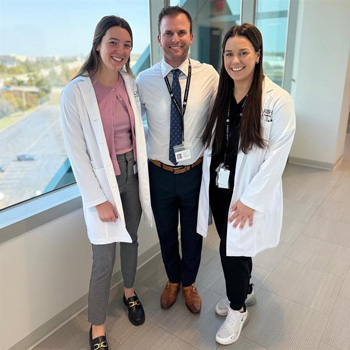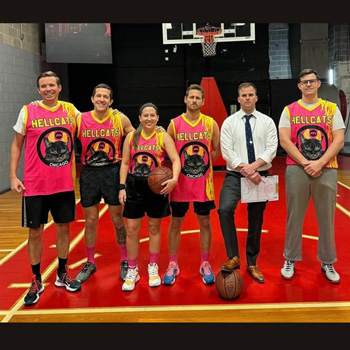Hip Anatomy
The hip is a ball and socket joint. The socket is the part of the hip bone called the acetabulum, and the head of the femur is called the ball. Articular cartilage lines the ball and the socket and functions to reduce friction for smooth joint movement. The labrum is ring of very strong fibrocartilage (like a rubberband) that attaches to the outer edge of the socket and deepens the hip socket.
The labrum plays an important role in maintaining normal hip function. It functions to tighten the seal between the bones for joint stability like a gasket, allows for a wide range of motion and helps to maintain the alignment between the bones. In a normal, healthy joint the ball fits tightly to the acetabulum. When the bones are abnormally shaped, they can rub against each other and damage the joint.
What is FAI?
FAI (femoroacetabular impingement) is hip impingement caused by a bony abnormality that leads to abnormal contact between the acetabulum and the femoral head. The abnormality maybe acquired (caused by injury or repetitive movements) or a developmental deformity. Hip deformities and the abnormal growth of bone on the ball and/or the socket alter normal biomechanics and can lead to hip impingement, labrum injury, and accelerated joint degeneration. FAI is a common cause of hip and groin pain in young, active patients. Repeated microtrauma from impingement can cause bone spurs, damage to the labrum, and cartilage; ultimately resulting in hip joint degeneration and osteoarthritis.
What are the symptoms of FAI and a labral tear?
Most labral tears are due to FAI, and the symptoms usually overlap. Labral tears typically do not heal on their own because of the limited blood supply to the labrum. Some people may coexist with their labral tear and continue to live active lives and never have problems. However, the onset of symptoms may indicate progressive and more serious damage to the cartilage or labrum.
Common symptoms include:
- intermittent deep groin pain or ache (most common)
- pain at the outside of the joint
- sharp stabbing pain when twisting, turning or squatting as when getting in or out of a car or a chair
- a dull ache from prolonged sitting or walking
- a clicking or locking sound when the hip is moved
- instability and decreased range of motion
- stiffness and limping
How is FAI diagnosed?
First, your medical history, symptoms, past injuries and the movements that cause your pain will be reviewed. A physical examination checking range of motion, flexion, adduction and rotation will be performed to diagnose the most likely cause of the symptoms. Sometimes, if the source of the pain is unclear based on the history and physical examination, a cortisone injection can help to confirm the etiology of the pain and diagnosis. For instance, if the injection is performed within the hip joint and the pain goes away, it confirms that the source of the pain was intra articular FAI.
Imaging tests are necessary to definitively diagnose your condition. X-rays will typically reveal abnormally shaped bones, and an MRI will reveal damage to the soft tissue or the labrum. A CT scan may be necessary to provide addition detail about the shape of the bones and determine the exact site of bony impingement.
Can hip impingement cause buttocks pain?
Yes. While pain and discomfort from hip impingement is typically felt in the groin, it can also be referred to other locations such as the thigh or the buttocks. Additionally, it can cause low back pain and lateral sided hip pain. Typically pain is worse with hip flexion, such as getting into or out of car or chair.
What causes FAI?
FAI is the result of an abnormally shaped hip joint that is typically present long before symptoms begin. Many people with a misshapen hip joint may not cause problems until the hip is put in certain positions during sport or activity. Impingement pain is often misdiagnosed as hip bursitis or a hip muscle strain or injury due to trauma to the hip joint.
What is the hip impingement test?
The impingement test attempts to replicate the pain or discomfort the patient experiences with activity. This maneuver entails bringing the knee to your chest and then rotating it in toward the opposite shoulder (FADIR [flexion adduction and internal rotation]). If this is similar to the pain that a patient experiences, the pain is likely due to FAI. However, confirming the diagnosis will include the imaging tests mentioned above. A comprehensive physical exam is key to determine the cause of your pain.
Does a hip impingement need surgery?
Many people have abnormally shaped hips and FAI however never become symptomatic or have pain. The onset of symptoms may signal early or progressive damage to the hip cartilage or labrum and with repeated use, this damage may more rapidly progress. The reason athletes are often diagnosed with FAI is because they overuse the joint in extreme ranges of motion which more quickly damages the labrum and causes pain.
In mild to moderate cases symptoms can often improve with nonsurgical treatment. This involves a change in activities to avoid positions that cause pain during exercise or athletics, using over-the-counter anti-inflammatory medications to reduce pain and inflammation, and physical therapy. Symptoms should resolve within several weeks. Corticosteroid injections can also help relieve pain should the above measures provide incomplete relief. Chiropractic treatments can sometimes aggravate the condition.
When is surgery indicated?
When nonsurgical treatments do not relieve pain and imaging reveals structural damage to the labrum or articular cartilage surgery is recommended. Surgery can be performed in a minimally invasive procedure called hip arthroscopy which is usually an outpatient procedure.
How long does it take to recovery from hip surgery for FAI?
Most people can recover full, unrestricted activity in 4-6 months with a good physical therapy program.
What is hip preservation?
Hip preservation refers to the use of procedures to protect and maintain the labrum (the cartilage that lines the hip bone to deepen the hip socket) to prolong the natural lifespan of the hip, prevent arthritis of the joint, and to avoid or delay hip replacement surgery.
FAI Treatment Options
When the symptoms are typical of FAI and diagnosis is confirmed by physical examination and imaging, intervention is warranted to prevent the onset or progression of osteoarthritis.
Nonsurgical treatment
Initially, nonsurgical treatment may be recommended. It includes physical therapy to improve function and decrease pain, activity modification, over-the-counter pain medications, rest and cortisone injections. Conservative management can help relieve symptoms of a small tear but cannot fix the tear or the impingement.
The approach to surgical treatment is centered around hip preservation, pain reduction, and maximizing the longevity of the native joint to avoid hip replacement. Surgery is tailored to each patient’s specific needs.
Surgery
FAI is a complex problem. Each of the elements below must be addressed during surgery to provide a durable solution to decrease pain and dysfunction, and to avoid the limitations and disadvantages of joint replacement.
Hip deformities and abnormal bone growth results in a mismatch of the hip bones causing abnormal hip motion that causes the impingement of soft tissue which leads to pinching and tearing of the labrum. Labral damage destabilizes the hip joint, causing additional joint impairment, which can further restrict motion causing weakness and instability.
Weakness and instability lead to compensatory behavior that results in changes in gait to off load the affected hip and reduce pain by displacing the center of gravity. However, favoring the affected hip also results in muscle disuse and dysfunction. This can place excessive demand on the muscles, ligaments and tendon in the hip which causes progressive damage to the labrum and cartilage.
Misalignment of the bones and compromised joint stability leads to the degeneration of the articular cartilage on the ball or femur, and the acetabulum or hip bone which leads to osteoarthritis of the hip. FAI is a significant contributor to the development of premature hip arthritis and joint deterioration. Surgical correction of symptomatic FAI with joint preservation with arthroscopy, cartilage restoration, and surgical repair or reconstruction of labral tears.
Hip Arthroscopy
When symptoms persist or the tear is severe, hip arthroscopy is a well-established surgery to treat FAI and related defects including labral tears, ligament injuries and damage to the articular cartilage. Arthroscopy is minimally invasive surgery that reduces pain and improves function in patients of all ages. Hip arthroscopy offers faster recovery, lower complication rates, less trauma and bleeding, and less pain compared to open surgical techniques.
Who is a good candidate for hip arthroscopy for FAI?
FAI is a common cause of hip and groin pain in young, active patients, and predisposes to premature joint degeneration. Intra – articular injection of Marcaine or cortisone that reduces pain is an indicator of positive outcome with hip arthroscopy. In this group of patients, hip arthroscopy provides optimal outcomes. However, pre-existing osteoarthritis and cartilage damage are factors that negatively affect the outcome of hip arthroscopy for FAI. For this reason, when advanced age or more severe degeneration are present, hip arthroplasty or hip joint replacement may be recommended.
Hip Arthroscopy Procedure
Hip joint deformity that causes impingement is addressed with femoral head and acetabular osteoplasty. The bones are surgically reshaped, so they fit together without friction which prevents damage that leads to osteoarthritis. However, the exact surgical procedure is determined by the type of impingement. Hip arthroscopy is performed using general anesthesia.
The torn labrum can be either repaired or reconstructed to reseal the ball and socket joint. Repair of small tears may be accomplished by sewing the tear together. However, when the labrum is torn off the bone, arthroscopic reconstruction may be needed.
FAI Recovery
You will be provided with full post-operative instructions.
How long does it take to recover from symptomatic FAI without surgery?
Exercise is the best way to improve pain and return to normal daily activity and recreational pursuits. Recovery includes 6-8 weeks of physical therapy with modifications to decrease pain, inflammation and swelling. Therapy progression includes exercises for range of motion, flexibility, muscle strength and endurance, balance, proprioception and control.
How long does it take to recover from surgery?
Recovery from arthroscopic FAI correction is typically 4-6 months with early pain relief and functional improvements in daily activities at 3 months post op. Restoration of sporting activities is possible between 6 months and a year post op. Therapy is focused on restoring range of motion, and improving muscle strength, flexibility and stability.
Gentle range of motion exercise and continuous passive motion can prevent stiffness, pain, and adhesions. Controlled and gradual weight bearing exercise is essential to protect the joint. Inactivity and immobilization increase the risk of muscle atrophy and stiffness. Aggressive post-op rehab is coupled and balanced with the patient’s healing, strength, range of motion, biomechanical function and confidence.
Immediately after surgery
- Pain: Take the pain medications as instructed.
- Showering: Keep the incisions dry, do not shower for the first 48 hours following surgery, after which the bandages can be removed, but keep the steri-strips in place. Then, cover with a waterproof bandage when showering.
- Crutches and Brace: Crutch and brace use are essential following surgery. You should remain non weight bearing for the first 24-36 hours after surgery. It can take 3-4 weeks before the patient gets can completely transition from crutches. Wear the brace when using crutches.
- Icing and CPM: Begin icing the hip the first few days to help reduce swelling. The continuous passive movement machine (CPM) will gently move the operated leg to prevent stiffness and reduce scarring. At night we advise the use of padding for 2 weeks to protect the hip and keep the hip in the appropriate rotation.
- Upright biking: Upright biking without resistance can begin one day post op using only the non-operative leg to push the operative leg for about 20 minutes at a time.
- Change position: We recommend changing positions frequently to prevent stiffness. Every 30 minutes alternate sitting, reclining, and lying down. Do not sit for longer than 30 minutes. Spend 2-3 hours on the stomach with the legs straight. Perform ankle pumps and elevate the leg to prevent blood clots.
- Physical therapy: Physical therapy begins within the first few days following surgery. The patient learns to use crutches, passive range of motion exercises, and isometric exercises. Physical therapy will be two times per week for about 3 months.
Physical Therapy
Effective post op rehabilitation is individually tailored and modified with precautions based on the type of surgery. Post-operative healing requires a balance between protecting the joint so it can heal and providing sufficient motion to rehabilitate the joint, muscles, ligaments and tendons.
5 – Phase Rehabilitation
- Phase 1: The first 2-6 weeks after surgery, the patient will use crutches as needed. The goal is to protect the joint, manage pain and begin rebuilding muscle strength, flexibility and range of motion. At week 2 the patient can begin to weight bear as long as the pain doesn’t increase with walking.
- Phase 2: The goal of the next 4-6 weeks is restoration of range of motion, and reeducation of the muscles by performing progressive strength and endurance exercises targeted to the glutes, hamstrings and quads to get them ready for walking. Core strengthening is necessary to improve stability. During this time, progressive weightbearing exercises will begin.
- Phase 3: Gait normalization and strength optimization to prepare the patient for return to the daily activities of life.
- Phase 4: Dynamic stability and proprioceptive training. Cardiovascular endurance exercises and advanced strength training.
- Phase 5: The final phase is the determination that the patient is ready to return to sports. This involves the patient, the surgeon and the physical therapist.








